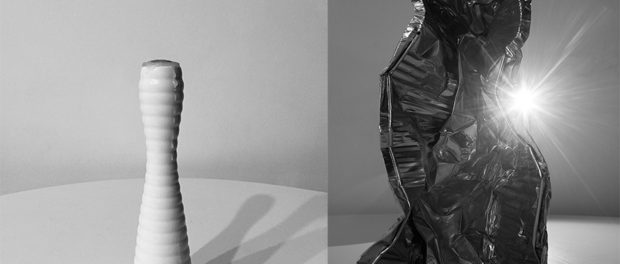Long Way Gone: Ways of Representing One(self)
Written by Stephanie Gagné
How can artists implement them(selves) and their identities within their artworks? What artistic strategies and materials do they use? Is being the subject of the work enough or are there other ways of presenting one’s self. These questions are considered at Galerie Trois Points’s ambitiously curated solo exhibition of Canadian/Serbian artist, Milutin Gubash (b.1969), Long Way Gone. The exhibition focuses on the performativity of objects through a constellation of narratives focusing on issues of identity, politics and history.
The central artwork of the exhibition is said to hold a part of Milutin Gubash’s soul; a white ceramic vase with circular grooves sits on a large white plinth. Curiously small in size, it is interesting to consider how Gubash scales the vase according to what he believes the measurements of a soul are. From the white vase and plinth, as well as the white cube space, the emphasis of white is overwhelming; it feels as though one is in a sanctuary of purification, moreover, another realm, which is further emphasized by the fact that a Parisian witch extracted the artist’s soul into the receptacle. How did the witch perform this act? What happens now that the artist’s soul has been disrupted? The viewer is left to their imagination.
Adjacent to the purist aesthetic of the space is another room, which contrasts noticeably as it is filled with drawings, photographs, sculptures, a marionette and a video. The curatorial display establishes interactivity, not only through the various shapes and forms of the artworks, but of the low hanging lamps, constructed from diverse materials from Serbia. As one moves around the lamps, the viewer is presented with three watercolor paintings of a naked Gubash depicted within the exhibition space, identical or similar to the artworks presented in Long Way Gone. Here, Gubash strips himself into a vulnerable state, alone, with the artworks he produced.
The artist refers to his cultural roots between Monuments to Communists (4), a black-and-white photograph of a forgotten propagandistic monument, located somewhere in the vast landscape of former Yugoslavia, and Propositions for a Monument, a photographic series of twisted and thwarted aluminum sculptures referencing Tatlin’s Tower. The artworks are dialogically curated as they hang facing each other on opposite walls, both literally and figuratively representing the failed utopia of Soviet communism through monumental architecture, and more generally, referencing the ways in which ideologies are utilized through the visual arts.
The rumbling sounds from a video, interestingly displayed low against the wall, showcases the artist as a marionette filming one of his aluminum sculptures from Propositions for a Monument. The video presents a multiplicity of layers as he plays with notions of the performativity of the subject and object; Gubash’s self is presented through a physical avatar videotaping his artwork; Gubash himself videotaped the performance of these objects and his marionette for the video; and he directly references the artworks displayed the exhibition space used for the video.
I would highly recommend this exhibition, however, the only criticism I have is that the gallery did not include labels identifying the title of the artworks, forcing the viewer to refer to a binder placed on a table near the entrance.
Find the details here . Visit soon! The exhibition finishes at Galerie Trois Points on December 17!






